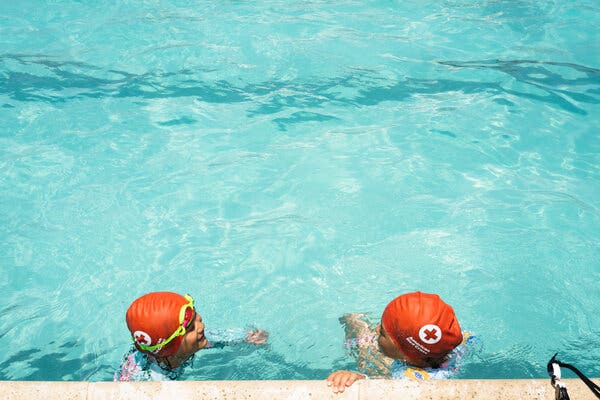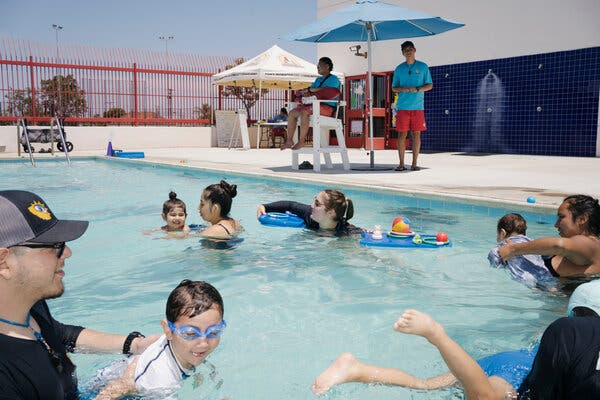
The sisters Adalynn and Sinclaire Wallace, 9 and 7, took a break during a swim lesson at Salgado Community Center in Santa Ana, Calif – Credit Gabriella Angotti-Jones for The New York Times
Drowning Is No 1 Killer of Young Children, US Efforts to Fix It Are Lagging
By Emily Baumgaertner
CA

(Emily Baumgaertner reported from community pools in Santa Ana, California)
Yadira Salcedo was born in Mexico to parents who did not know how to swim. As a child, she nearly drowned when she waded too deep in a backyard pool.
Now a mother of two in Santa Ana, California, Ms Salcedo is “breaking the cycle,” she said, making sure Ezra, 3, and Ian, 1, never experience such terror. The family has qualified for Red Cross scholarships to a new program that teaches children who might not have other chances to learn how to swim.
On a recent day, Ms Salcedo and her children climbed together into the Salgado Community Center pool, using kickboards and blowing bubbles with an instructor, Josue, who uses a mix of English and Spanish.
Drowning is the leading cause of death for children ages 1 to 4, according to the Centers for Disease Control and Prevention. Deaths are likely to surge this month, as they do every July, with children drowning just feet from their parents without a scream, struggle or splash. A 4-year-old at a Texas hotel pool, a 5-year-old in a California river, a 6-year-old at a Missouri lake and a 10-year-old at an Indiana public pool all drowned just this past week.
And yet, despite calls from the United Nations , the United States is one of the only developed countries without a federal plan to address the crisis. Thirty years of progress in decreasing the number of drowning deaths in the country appears to have plateaued, and disparities in deaths among some racial groups have worsened.
“It’s hard to imagine a more preventable cause of death. No one is going to say, ‘Oh, well, some people just drown,’” said William Ramos, an associate professor at Indiana University School of Public Health-Bloomington and the director of the school’s Aquatics Institute.
“It’s time to go deeper than the sad statistics and answer the ‘why’ and the ‘how,’” he said.
A parent who has never learned to swim yields an 87 percent chance that a child won’t, either, said Dr Sadiqa A.I. Kendi, the division chief of pediatric emergency medicine at Boston Medical Center, who studies the cyclical nature of injury and inequity .
“This is anthropology,” said Mr Ramos. “To start a new narrative around water is not an easy task.”
The National Institutes of Health recently published a call for research proposals to examine drowning prevention, writing that “little is known” about what intervention strategies work. The CDC said it planned to do an in-depth analysis of childhood drownings in several states to better understand the contributing factors.
But epidemiologists point to an array of factors that could make it increasingly difficult to close the gap, including shrinking recreation department budgets, a national lifeguard shortage and an era of distraction on pool decks, as parents juggle child supervision with laptops and cellphones when they work from home.
In the longer term, the figures are likely to be exacerbated by climate change, said Deborah Girasek, a drownings researcher at the Uniformed Services University of the Health Sciences. More children are likely to drown in hurricane floodwater in Florida, fall through thin ice in Wisconsin or climb into restricted reservoirs in Yosemite for a reprieve from the increasing heat. (Research shows that drownings rise with every degree on a thermometer.)
Though overall drowning deaths have decreased by one-third since 1990, they have risen by 16.8 percent in 2020 alone, according to the CDC. There are still over 4,000 of them in the United States annually, and about a quarter of the deaths are of children. An analysis by the CDC shows that Black children between ages 5 and 9 are 2.6 times more likely to drown in swimming pools than white children, and those between ages 10 and 14 are 3.6 times more likely to drown. Disparities are also present in most age groups for Asian and Pacific Islander, Hispanic, and Native American and Alaska Native children.
Socioeconomic factors are at play as well. A study of drownings in Harris County, Texas, for example, showed that they were almost three times more likely for a child in a multifamily home than in a single-family residence, and that drownings in multifamily swimming pools — like the one at the Salcedos’ apartment — were 28 times more likely than in single-family pools.
Ms Salcedo said she often saw children swimming in the pool of her apartment complex unsupervised, the gate propped ajar with a water bottle or a shoe.
The leading theory to explain the inequities traces back half a century to the proliferation of municipal pools after World War II. When those gave way to suburban swim clubs and middle-class backyard pools, the historian Jeff Wiltse wrote in his book on pool history , white children began learning to swim in private lessons, while children in minority families saw public pools become dilapidated and aquatics budgets be slashed. Many of the facilities and education programs have never recovered.
Black adults in particular report having had negative experiences around water, with familial anecdotes of being banned from public beaches during Jim Crow-era segregation and brutalized during the integration of public pools.
A UN resolution issued in 2021 and a World Health Assembly decision this year to accelerate action urged every member nation to prioritize the fight against childhood drownings. Both the WHO and the American Academy of Pediatrics have implored the United States government to catch up.
“Canada, UK, Australia, New Zealand, South Africa — they all have a plan. We don’t,” said Mr Ramos. “The message to Congress is: We need to fix this, and we can. But look at seatbelts, fire safety, smoking cessation. Legislation is what’s going to move the needle.”
Officials could add aquatics to gym class curriculums or mandate four-sided pool fences in backyards (since many victims still wander into pools from the exposed side facing the house). Ms Girasek said she was eager to see legislation because “we see very clearly that it works.”
After former Secretary of State James Baker’s 7-year-old granddaughter Virginia Graeme Baker was trapped by the suction of a hot tub drain and drowned, a federal law was named in her honor that required public pools and spas to be equipped with drain covers that meet certain standards. It seemed to all but eradicate such deaths.
The US National Water Safety Action Plan, launched by a group of nonprofits last week, is the country’s first-ever attempt to construct a road map to address the crisis. Its 99 recommendations for the next decade serve as a sobering guide through the country’s various gaps in research, funding, surveillance and parental education, compiled by earnest advocacy groups on shoestring budgets that aren’t equipped to fill them alone.

Ms Gonzalez, blowing bubbles for Luna - Gabriella Angotti-Jones for The New York Times
Connie Harvey, the director of the Aquatics Centennial Campaign at the American Red Cross, held a Capitol Hill briefing recently alongside other experts, she said, “to let our leaders know that there is a plan — that this plan exists.”
Representative Debbie Wasserman Schultz, Democrat of Florida and a longtime advocate for drowning prevention, was the only member of Congress to attend.
In the meantime, some local governments have adopted their own interventions. This summer, Seattle is piloting a new initiative based on the nonprofit No More Under , which connects hundreds of low-income and foster children with swim lessons. Broward County, Fla, which has some of the highest drowning rates in the state, is offering free vouchers. And Santa Ana plans to pull more than $800,000 from its Cannabis Public Benefit Fund this year to bring its aquatics program back under its domain.
The city, with a population that is nearly 80 percent Hispanic nestled between wealthier Orange County suburbs, has historically epitomized racial and economic health disparities. One of its public pools is 63 years old. But its Parks and Recreation Department recently hired an aquatics supervisor and 36 new lifeguards — several of whom the supervisor needed to first teach to swim.
Under the new Santa Ana program, Ms Salcedo, a waitress, and her husband, a post office employee, who live in a three-generation household, secured scholarships that brought the cost of swim lessons down to $15 per child every two weeks. They plan to attend all summer.
Ezra, who is 3, cried on the first day of lessons. Now he shares facts about hammerheads between strokes during the “Baby Shark” singalong. Ian, the 1-year-old, has not yet mastered walking on land. Still, he paddled after an orange rubber duck, with his mother — now a proficient swimmer — keeping him afloat. – The New York Times

